Özyeğin Üniversitesi
Trace Sınavı İngilizce Hazırlık Programı
Özyeğin Üniversitesi – Trace Sınavı İngilizce Hazırlık Programı
Özyeğin Üniversitesi Trace sınavı İngilizce Hazırlık Programı hazırlık okulunda okuyan İngilizce Düzey Belirleme Sınavında başarılı olan veya İleri düzeyi tamamlayan öğrencilerin TRACE sınavına girme hakkı kazanıp kazanmadıklarını belirleme sınavıdır.TRACE, öğrencilerin fakültelerinde İngilizce olarak görecekleri bölüm derslerini takip edebilecek yeterliğe sahip olup olmadıklarını ölçümlemek için hazırlanmıştır.
Üniversite öğrencilerinin fakültelerine başlayabilmeleri için TRACE sınavından en az 65 almaları lüzumludur.Sınav belli bir konu başlığına dayanmaktadır.Tüm bölümleri de bu konu başlığı ile bağlantılıdır.
Belli bir konu başlığına dayandırılmasının sebebi öğrencilerin eleştirel düşünebilmelerine bununla birlikte onlara sunulan bilgiyi işleyebilmelerine imkan sağlamaktır.
Eleştirel düşünebilme ile bilgiyi işleyebilme becerileri üniversite öğrencilerinin akademik bağlamda kullanacakları gerçek hayat ihtiyaçlarını yansıtır.
Sınavlar doğrudan doğruya akademik amaçlı okuma, yazma, ve dinleme becerilerini ölçer.
Özyeğin Üniversitesi
Trace İngilizce Hazırlık Programında Dilbilgisi ve kelime bilgisi ise direkt olarak ölçülmez.
Öğrencilerin bu alanlardaki yeterlikleri dili hangi ölçüde kavrayabildikleri ve kullanabildikleri değerlendirilerek saptanır.
TRACE Avrupa Dilleri İçin Ortak Başvuru Metnin’de belirtilen dil kullanıcısı düzeyleri (B1, B2, C1) referans alınarak hazırlanmıştır.
Sınav B2 düzeyindeki bir öğrencinin dil yeterliğini ve dil becerilerini ölçmektedir.İçeriğini genel olarak akademik metinler oluşturmaktadır.Bunun nedeni öğrencilerin öğrenim dili %100 İngilizce olan bir üniversitede okuyacak olmalarıdır.
Sınav Bölümleri
Dört bölümden oluşmaktadır.
Ancak birinci bölüm değerlendirilmez.
Özyeğin Üniversitesi – Trace İngilizce Hazırlık Programı Bölümler:
1. Bölüm: TRACE’e Hazırlık
Bölümün amacı öğrencilere sınavın içeriğini oluşturan konu başlığını tanıtmak ayrıca öğrencilerin konu başlığı ile ilgili bilgi ve düşüncelerini gözden geçirmelerine fırsat vermektir.
Bu aşamada öğrencilerden sınavın konu başlığı ile ilgili grafik, çizelge, veya resimlere bakarak not tutmaları istenecektir.
Böylelikle öğrenciler, sınavın içeriğini oluşturan konu ile ilgili varolan bilgi ve düşüncelerini gözden geçirerek, sınavın sonraki bölümlerine hazırlanacaklardır.
Özyeğin Üniversitesi
Bu bölüm 15 dk. sürmektedir ve notlandırılmayacaktır.
TRACE’e Hazırlık- INTRODUCTION TO THE TEST Örnek sınav içeriğini indirmek için tıklayınız.
2. Bölüm: Reading
Sınavın bu bölümü 80 dk sürmektedir.
Sınav toplam puanlamasında ağırlığı % 30 dur.
Bu sınav dört alt bölümden oluşmaktadır.
Birinci alt bölüm iki adet kısa okuma parçasını içermektedir (her okuma parçası en fazla 250 kelimedir).
İkinci alt bölüm orta uzunluktaki bir okuma parçasını içermektedir (500 kelime civarında).
Üçüncü alt bölüm yaklaşık bin kelimelik uzun bir okuma parçasından oluşur.
Okuma bölümünün son kısmı ise öğrencilerin okudukları tüm okuma parçalarını karşılaştırarak cevaplandırmaları gereken sorulardan oluşmaktadır.
TRACE READING Örnek sınav içeriğini indirmek için tıklayınız.
3. Bölüm: Listening
Sınavın bu bölümü 50 dk sürmektedir. Ve sınav toplam puanlamasında ağırlığı % 30 dur.
Bu bölümü iki kısımdan oluşmaktadır.
Birinci kısım 10-12 dakikalık bir ders metnidir.
Öğrencilerin metni dinlerken aynı zamanda not tutmaları gerekmektedir.
Bu kısımda öğrenciler, önce metni dinleyecekler, sonra metin ile ilgili soruları göreceklerdir.
Daha sonra ise metni dinlerken tuttukları notları kullanarak sınav sorularını cevaplandıracaklardır.
İkinci kısım bir veya iki adet söyleşiyi içermektedir.
Bu bölümde öğrenciler önce söyleşiler ile ilgili sınav sorularını göreceklerdir.
Daha sonra da söyleşileri dinleyecekler ve aynı süre içerisinde söyleşiler ile ilgili sınav sorularını cevaplandıracaklardır.
Bu bölümde öğrencilerin not tutmaları gerekmemektedir.
Özyeğin Üniversitesi – Trace İngilizce Hazırlık Programında
TRACE LISTENING Örnek sınav:
Section 1 : İçeriğini indirmek için tıklayınız. Note taking sheet için tıklayınız. Ses dosyası için tıklayınız.
İçeriğini indirmek için tıklayınız. Note taking sheet için tıklayınız. Ses dosyası için tıklayınız.
Section 2: İçeriğini indirmek için tıklayınız. Ses dosyası için tıklayınız.
4. Bölüm: Writing
Sınavın bu bölümü 60 dk sürmektedir.
Sınav toplam puanlamasında ağırlığı % 40 dur.
Sınavın son bölümünde öğrencilere sınav içeriğini oluşturan konu başlığı ile ilgili bir soru sorulacaktır.
Öğrencilerin yaklaşık 250 kelimeden oluşan akademik bir paragraf yazarak bu soruyu cevaplandırmaları istenecektir.
Bu bölümde sürenin kullanılması noktasında önerilen planlamaya 10 dk. , kompozisyon yazılımına 45 dk, düzeltme ve kontrol için 5 dk. ayrılmasıdır.
TRACE WRITING Örnek sınav içeriğini indirmek için tıklayınız.
Özyeğin Üniversitesi
TRACE EĞİTİM PROGRAMIMIZ
W.O.L.A. ile ÖZYEĞİN-TRACE/TOEFL-PTE sınavlarında, siz de bizimle başaranlar arasında yerinizi alın!
Hazırlık sınıfında bir yıl kaybetmeyin! Hazırlık sınıfını W.O.L.A. ile geçeceksiniz!

TRACE SINAVI HAZIRLIK PROGRAMIMIZ;
ÖZYEĞİN-TRACE SINAV SİSTEMİNE ÖZEL EĞİTİM VERMEKTEYİZ.
TRACE ve MAT-LAT SINAVLARINA YÖNELİK ÖZEL SINAV PROGRAMI UYGULAMAKTAYIZ.
WHILE-LISTENING-NOTE TAKING ÇALIŞMASI İÇİN
WOLA TARAFINDAN ÖZEL HAZIRLANMIŞ ÖZYEĞİN-TRACE SINAVI ÖRNEKLERİ UYGULANMAKTADIR.
HAZIRLIK OKULU TECRÜBESİ OLAN EĞİTMENLER İLE ÇALIŞIYORUZ.
KİŞİYE ÖZEL WRITING EĞİTİMİ VERMEKTEYİZ.
HAFTA İÇİ ve HAFTA SONU ETÜT PROGRAMLARIMIZ MEVCUTTUR.
BİRE-BİR ÖDEV VE ESSAY YAZIM-KONTROL TAKİBİ UYGULAMAKTAYIZ.
WOLA Eğitim Materyalleri Kullanılmaktadır
*Tüm eğitmenlerimiz HAZIRLIK ATLAMA-PROFICIENCY eğitiminde uzman ve tecrübeli akademisyenlerdir.
*Kursumuzda bulunan geniş arşivimiz- ÖZYEĞİN ÜNİVERSİTESİ-TRACE SINAVI hazırlık materyalleri ile öğrencilerimizin hizmetindedir
*Öğrencilerimizin seviyeleri için ücretsiz seviye belirleme;
Örnek (ÖZYEĞİN ÜNİVERSİTESİ-TRACE SINAVI) ile belirlenmekte ihtiyacına en uygun ve amacına yönelik doğrultuda bir program oluşturularak hedefe ulaşmalarına yardımcı olunmaktadır.
*Sınavda başarılı olabilmek için gerekli ve yeterli dil seviyesine sahip olmayan adaylar için (PRE-TRACE EĞİTİMİ) özel çalışma programları ve bireysel eğitmen desteği ile öğrencilerimiz kısa zamanda hedeflerine ulaşabilmekteler.
Ayrıca sadece sınav başarısı değil aynı zamanda akademik hayatları boyunca gerekli tüm dil yeterliğine ve donanımına sahip olacaklardır.
*Vocabulary (kelime) dağarcığının zenginleştirme amacıyla özel kelime programları sayesinde öğrencilerin sadece kelime öğrenmeleri değil aynı zamanda öğrendikleri kelimeleri çeşitli cümleler içerisinde kullanarak tam öğrenmeyi gerçekleştirmeleri hedeflenmektedir.
*Bilindiği üzere ÖZYEĞİN ÜNİVERSİTESİ-TRACE sınavı 3 ana bölümden oluşmaktadır – Listening, Reading, Writing.
*Öğrencilerimizin bu 3 alanda da etkin bir başarıya sahip olabilmesi için eğitmenlerimiz tarafından sınav formatında tüm soru tipleri-yazım öğretim teknikleri ile birlikte “reading”-“listening”-“writing” bölümleri için özel çalışma programları uygulanmaktadır.
Özyeğin Üniversitesi-Trace sınavı formatında sadece ezbere ve kalıplara bağlı kalınarak değil, öğrencilerin kelime dağarcığı zenginleştirilerek yaratıcı düşünme ve uygulama becerileri geliştirilmektedir.
ÖZYEĞİN ÜNİVERSİTESİ-TRACE SINAVI için uyguladığımız eğitim Genel İngilizce eğitimi değildir.
Özyeğin Üniversitesi
TRACE sınavı için, hedefe ve sonuca odaklı AKADEMİK İNGİLİZCE eğitimi verilmektedir.
*Öğrencilerimiz için ders dışında etüt saatlerinde etüt-essay yazım destek programlarımız ile öğrenmeye devam etmektedirler.
*Verilen ödevlerimizin takibi, ders dışında uzman eğitmenlerimiz tarafından öğrencilerimizin eksikleri tespit edilerek ve desteklenerek dikkatli bir şekilde takip edilmektedir.
***CELTA (CAMBRIDGE CERTIFICATED TEACHER) sertifikalı tüm Türk ve yabancı eğitmenlerimiz ile ders içi ve ders dışında tüm öğrencilerimiz yeterli ve çokça pratik yapma imkanı bulmaktadırlar…
*Aynı zamanda öğrencilerimizin fakülteye geçtiklerinde İngilizce derslerinde zorlanmamaları için ÖĞRENEREK BAŞARIYORUZ…
ÖZYEĞİN ÜNİVERSİTESİ-TRACE SINAV ÖRNEKLERİNE- BÖLÜMLERİNE GÖRE WRITING-READING-LISTENING TAKTİKLERİNE ……
https://wola.com.tr/ozyegin-universitesi-trace-sinavi/ linkinden blog sayfamızdan ulaşabilirsiniz…












